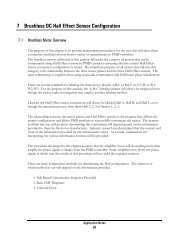Spin Coating Application for Semiconductor Wafers - Performance ...
Spin Coating Application for Semiconductor Wafers - Performance ...
Spin Coating Application for Semiconductor Wafers - Performance ...
Create successful ePaper yourself
Turn your PDF publications into a flip-book with our unique Google optimized e-Paper software.
<strong>Spin</strong> <strong>Coating</strong> <strong>Application</strong> <strong>for</strong> <strong>Semiconductor</strong> <strong>Wafers</strong><br />
Accurate velocitycontouring <strong>for</strong> controlled coating thickness<br />
<strong>Application</strong> Challenge: Maximize the uni<strong>for</strong>mity of thin film thickness<br />
<strong>Spin</strong> coating is a procedure used to apply uni<strong>for</strong>m thin films to flat substrates. In short, an excess amount of a<br />
solution is placed on the substrate, which is then rotated at high speed in order to spread the fluid by centrifugal<br />
<strong>for</strong>ce. The thickness of the coat is related to the spinning velocity, and <strong>for</strong> how long it is spinning at different speeds.<br />
Acceleration also affects the coated film’s properties as it provides a twisting <strong>for</strong>ce to the resin. <strong>Spin</strong> speeds vary<br />
between 500 rpm and 10,000 rpm, depending on the resin used and the required thickness.<br />
<strong>Application</strong> considerations:<br />
Feature/Function<br />
Units<br />
Velocity range:<br />
Accuracy and<br />
repeatability:<br />
Accelaration/<br />
Deceleration:<br />
500 rpm – 10,000 rpm<br />
+/‐ 1 rpm<br />
+/‐ 1 rpm/sec<br />
<strong>Spin</strong> <strong>Coating</strong> Process<br />
Motion Control Solution<br />
The diagram on page two shows an implementation using an ION 500 Digital Drive to control the spin velocity and<br />
acceleration. The system host computer controls the ION 500 through a serial RS485 link.<br />
Velocity profile mode with time break points<br />
Using the velocity profile mode the system can be set up to change the velocity at predetermined time points that<br />
match the specific thin film coating recipe. In velocity contouring profile mode the motion is controlled by changing<br />
the acceleration, velocity, and deceleration parameters while the profile is being executed.<br />
Breakpoints<br />
The ION supports up to 2 breakpoints. The trigger condition can be one of 10 parameters. For this application the<br />
trigger condition is time. At each trigger point the acceleration and velocity parameters are updated and the next set<br />
of parameters is buffered in preparation <strong>for</strong> the next trigger.<br />
Solution Note: <strong>Spin</strong> <strong>Coating</strong> 10‐10‐08
Solution Note: <strong>Spin</strong> <strong>Coating</strong> 10‐10‐08<br />
Field Oriented Control (FOC)<br />
Field oriented control is ideal <strong>for</strong> this high RPM spinning application. Field Oriented Control provides the smooth<br />
motion at slow speeds as well as efficient operation at high speeds. FOC also can improve motor efficiency and can<br />
help in motor sizing. Also, the fully digital control loops, and easy to use hardware trace feature <strong>for</strong> ultra‐accurate<br />
tuning can improve the overall motion system.<br />
Auto tuning, setup features and programming<br />
Pro‐Motion® GUI offers an axis wizard which helps designers quickly configure motion architectures <strong>for</strong> testing and<br />
includes an auto‐tuning feature <strong>for</strong> both current loop and position loop of servo motors. Scope tracing of motion<br />
parameters is a feature offered that is a useful tool <strong>for</strong> this application, as a way of measuring the velocity contouring<br />
profile. Programming is managed with C‐Motion®, a source code library of motion commands <strong>for</strong> development of<br />
C/C++ programs that run on the motion processor.<br />
Cover<br />
Resin <strong>Coating</strong><br />
Substrate<br />
System<br />
Control Board<br />
Fume<br />
exhaust<br />
Motor<br />
ION Digital<br />
Drive<br />
HMI<br />
ION<br />
The figure above illustrates the motion control connections from the system control card to the digital drive, motor<br />
and spin coating substrate. The digital drive provides motor control and amplification and can be connected via CAN<br />
or serial communication.<br />
The motion control features and products described in this solution would also apply to many other industrial<br />
applications such as spindle control, bar code reader or drum scanners/printers.<br />
The ION® Digital Drive is a compact, fully enclosed module that<br />
provides high per<strong>for</strong>mance motion control, network<br />
connectivity and power amplification <strong>for</strong> DC brush, brushless<br />
DC or step motors. Using advanced MOSFETs and surface<br />
mount technology, ION provides very high power density in a<br />
rugged, flexible <strong>for</strong>m factor. It per<strong>for</strong>ms profile generation,<br />
servo compensation, stall detection, field oriented control,<br />
digital torque control and many other motion control functions.<br />
Contact our customer support team at +1 781 674 9860 <strong>for</strong> more in<strong>for</strong>mation including details on<br />
Developer’s Kits and application support. We would like to assist you in improving your motion system.<br />
Per<strong>for</strong>mance Motion Devices, Inc. Tel: +1 781 674 9860 www.pmdcorp.com email: info@pmdcorp.com


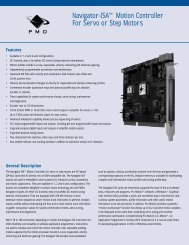
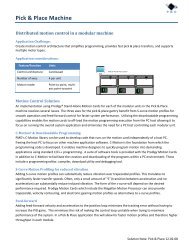
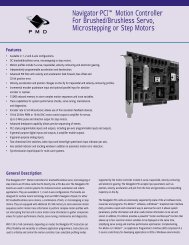
![Navigator MC2800 Datasheet [PDF] - Performance Motion Devices](https://img.yumpu.com/25398470/1/190x245/navigator-mc2800-datasheet-pdf-performance-motion-devices.jpg?quality=85)
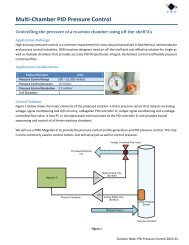
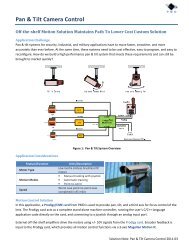
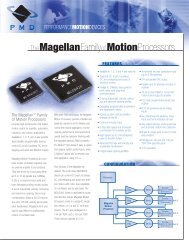
![Motion Control has a Field Day [PDF] - Performance Motion Devices](https://img.yumpu.com/22926252/1/190x245/motion-control-has-a-field-day-pdf-performance-motion-devices.jpg?quality=85)
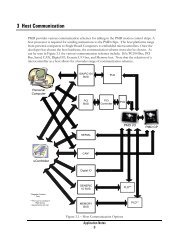
![New Developments in Commutation & Motor Control [PDF]](https://img.yumpu.com/17401848/1/190x245/new-developments-in-commutation-motor-control-pdf.jpg?quality=85)
